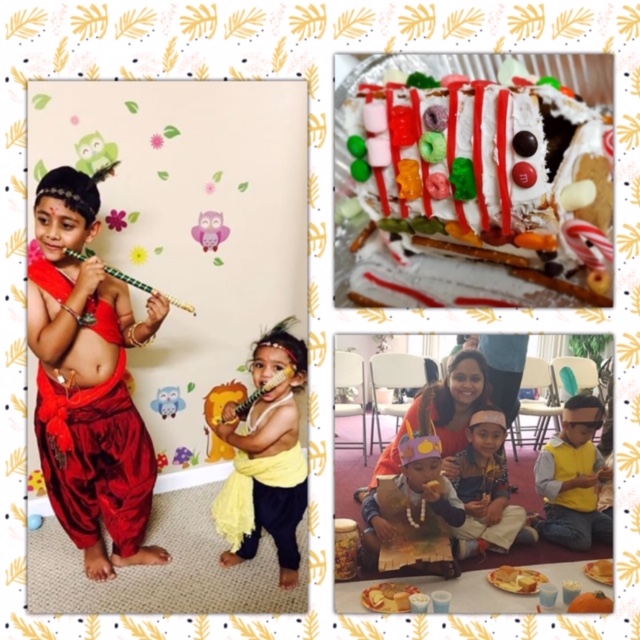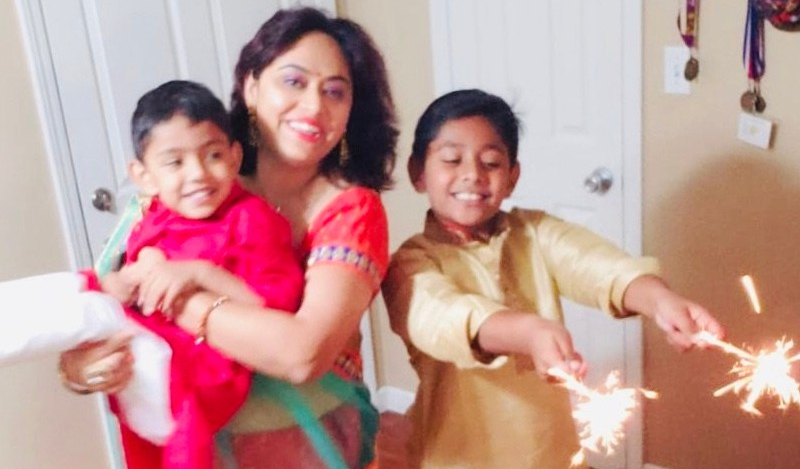It’s very challenging to raise bi cultural children. Bi cultural children are those, who are are a part of two (or more) cultures. If you are raising a child in two different cultures, you may feel a constant pressure to ensure your child understands, embraces, and respects your cultural heritage. At the same time, you want them to be well adjusted to their life in the United States, which you have worked so hard to give them.My kids celebrating Thanksgiving, Janmasthmi and Christmas
Culture and heritage consist of the passing of traditions and more from one generation to another. As parents, we often want to share with our children the best of our own lives and our traditions are a huge part of that. When raising children in a country different from the one in which you grew up, the challenge is that there are several competing cultures vying for their attention. But just like language, culture can shape the development of our children and families.s that may be vastly different from your own while you were growing up. And that’s ok. In fact, your child’s new experiences and their blended cultures will contribute to them being confident, creative, kind, and open-minded.

Benefits of being raised in a bicultural environment
The Journal of Personality and Social Psychology published a study in 2012 on the effects of multiculturalism on creative and professional success. In this study, subjects were asked to come up with creative uses for a brick. The bi-cultural subjects generated more ideas and more creativity. This study concluded that bi-cultural people could see things from multiple perspectives, allowing them to innovate and be creative with relative ease.
Experiencing and understanding different kinds of traditions, religions, languages, and practices broadens children’s minds. They get to see first-hand that there are different ways to live, celebrate, and express themselves. These differences provide advantages that help them excel in life. We belong to India, my little one is American citizen and the elder one is being raised, in American culture outside home. I agree, sometimes these cultures, ideas and the ways of upbringing conflicts. I remember, until I reached a certain age, I was never asked my choice for a dress, buying books or even the ice cream flavor. Parents especially mom’s use to know all about a child, and for me her choice was always perfect. We never disagreed. Here, in America, even a three year old will be asked for their choice and that will be genuinely followed and respected. Though, I took my own good time to accept and follow this behavioral norm here.
Sharing one of my personal experience on this context. :-)) It was a very cold day of January, few years back , and I was playing with my 4 years old in a neighboring park. Me and my child were with a cap and a jacket, as others. I saw a native mom, all warmed up in her thick jacket and cozy boots sipping coffee and asking her nearly 3 yr playing on slide in his cotton tee and pants, if he wants to wear a jacket or is he okay?? For which the answer was….”I am okay Mom”!!
I was like What!! How can he be okay; and if at all he is okay how can she be okay?? Fine with child’s answer mom went and sat, on the side benche and child continued sliding. Please don’t get me wrong here; I am not judging anyone here, just that, I didn’t get it.
What it means to be “Indian” or “American” for child?
It is important to acknowledge that many children don’t have a clear understanding of what it means to be “Indian” and “American” because there is no fixed definition of this. Every family has their own views and/or thoughts about this. The research confirms that everyone has their own version of what it means to be a “good” Indian. To some, being a “good” Indian means wearing Indian clothes, speaking the language and going to Indian cultural events. For others, being a “good” Indian means prioritizing family and taking care of elders.
Everyone constructs their own understanding of their Indian identity based on their experiences and their personal understanding of their cultural heritage. And one of the best ways to transmit your identity, your culture and your believe to your child is through positive communication, and by respecting their cross questions, hesitations and disbelieves. There will be circumstances or situations in which children may decide to place a value on the greater good of their family – and other situations in which they may choose to do something because of their self-interest. Let me share few of my ideas or practice which I follow at home.
- Communication
Talk talk and talk, on various topics. Ask them suggestions, take ideas. Share your views about. Have open ended and positive communication and don’t try to conclude the conversation. One conversation opens the path to another.
- Do not compare your childhood with them
Talk about your childhood back in country, but please avoid comparing it, with their present. As this country and the multicultural exposure is our gift to our kids. It’s not their choice, but ours. ” we only used to have one or two board games and toys….. Seeing their electronics gadgets, board games or toys, that we use to play with one or two toy when I was your age.
- Show interest and participate in their festival like Halloween, Easter , Thanksgiving etc and their activities as much as you want them to be with you for our native festivals.It is human nature to desire belonging. Many people feel isolated or describe not fitting in, and having surface relationship.
- Sense of Belongings
Help them to identify their culture, their heritage, where they belong to. The sense of belonging is very important. Don’t let them feel isolated or not fitting in problem. You can make some changes too if it interest them more.
- Tell them the importance and fun of knowing your own language It’s Important, because Children Need to Connect with Family and Friends on Both Sides of the Cultural Divide. One of the issues I most often read about in parent boards about multilingualism, is the difficulty that comes about when children can’t connect with family members due to language and cultural barriers. If children can’t communicate with family members and don’t feel a connection to their culture, it can create uncomfortable situations and missed opportunities. On the other hand, if you completely ignore the traditions of the majority culture, you and your family might be missing out on wonderful new experiences. Moreover, not embracing the majority culture might even create a barrier between you and your children as they grow up, so it’s important to make new traditions as a family and embrace the best of both worlds.
- Cook together When we raise our children in a country different than our own, we tend to cook meals we grew up with, as we probably learned how to make them at home with our parents and grandparents. Enjoying the smells and flavors of our childhood is a wonderful way to pass on our heritage, but exploring and enjoying the cuisine and tradition of the majority culture (along with other cultures!) is also important. Do we want our kids to miss out on the wonderful things this new country has to offer? No, so start planning to spend the weekend enjoying the special meal together.
- Read cultural books Reading is the best way to practice language and reading books that connect your children to your heritage culture can be a great bonding experience.
- Now a days,we see most of the our festivals being celebrated, near us. Make to attend festivals and such events where your culture is celebrated.
-
Listen and dance to the music of your culture.
-
Don’t forget to have a couple of traditional wear for your entire family next time you visit country. Believe me they will look adorable and they will love it. It will also help them connect more.

Living in two different cultures often translates to being able to adapt to different social situations in very creative ways. This creativity is not restricted to social situations; it spreads to every single aspect of their lives, making them out of the box thinkers. And this matters because when ideas come together, and even when they clash, we are more likely to see and solve problems. After all, isn’t that what we want for them?
What is your experience in raising bi-cultural children? Do you have any tips to share? Feel free to do so in the comments below! Together we can support each other in raising global citizens that honor their heritage and embrace their new culture by creating new traditions of their own.

Very well written. A lot can be learned and adopted.
LikeLiked by 1 person
Thank you!! You have always been an inspiration behind my blogs❤️
LikeLike
Proud of you Garima… super stuff.. keep it up!!
LikeLiked by 1 person
Thank you so much!! This is soo encouraging ❤️
LikeLike
Nice compilation
LikeLike
Well read… No doubt kids are being raised perfectly…
LikeLiked by 1 person
Thank you so much😊
LikeLike